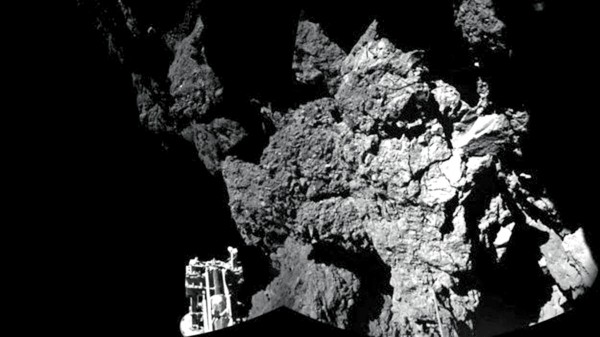《TAIPEI TIMES 焦點》 Space agency releases first photo from comet’s surface

A combination photograph of different images released by the European Space Agency yesterday shows the Philae lander on the surface of Comet 67P/Churyumov-Gerasimenko. One of the lander’s three feet can be seen at bottom left. Photo: Reuters
/ AP, BERLIN
The European Space Agency (ESA) yesterday published the first image taken from the surface of a comet, and said that its Philae lander is still “stable” despite a failure to latch on properly to the rocky terrain.
The lander on Wednesday scored a historic first when it touched down on comet 67P/Churyumov-Gerasimenko after a decade-long journey through space on its mother ship Rosetta.
The ESA says its comet lander appears to have come to rest in the shadow of a cliff, posing a potential problem for its solar panels.
Mission scientist Jean-Pierre Bibring said ground controllers would see whether it is possible to adjust the lander to make sure its solar panels can catch the sun and charge the batteries.
Bibring said that the lander also appears to be standing on just two of its three feet.
He added that — apart from the unplanned alignment — the lander’s scientific instruments are operating normally.
Scientists’ jubilation was slightly dampened because the harpoons that were meant to anchor the lander to the surface failed to deploy, causing it to bounce twice before it came to rest on the comet’s body, or nucleus.
“Philae is stable, sitting on the nucleus and is producing data,” said Gerhard Schwehm, a scientist on the Rosetta mission. “The lander is very healthy.”
The photographs sent back to Earth show a rocky surface, with one of the lander’s three feet in the corner of the frame.
Schwehm said it may still be possible to fire the harpoons, but that this would be done only if it does not imperil the lander.
A key question is whether Philae’s drill can be used to extract samples from beneath the surface without pushing the lander into space.
Gravity on the comet is 1/100,000th that of Earth, meaning the washing machine-sized lander weighs just 1g there.
Philae and Rosetta will use 21 instruments to analyze the comet over the coming months.
Scientists hope the 1.3 billion euro project (US$1.62 billion) will help them better understand comets and other celestial objects, as well as possibly answer questions about the origins of life on Earth.
新聞來源:TAIPEI TIMES














